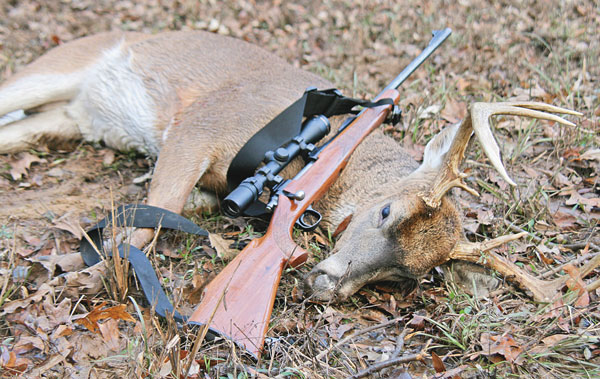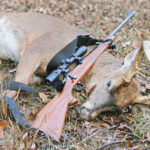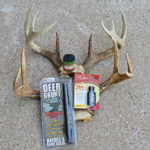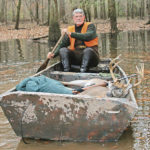
You should never head to a deer stand without your weapon, but a close second to that vital piece of equipment is a grunt call.
Over the last few decades, technology has dramatically altered deer hunting. With an endless variety of camouflage clothing, scent-control products, game cameras, range finders, feeders, climbing stands, pop-up blinds, cough suppressors and the like, today’s deer hunters have as many gizmos available to them as bass fishermen.
I learned a long time ago that if you stay downwind and keep still, a deer doesn’t really care what you wear or where you sit. So, truth be told, there are few deer hunting products that I feel I cannot leave home without.
One of those rare essential items is a deer call.
When Haydel’s Game Calls came out with the first tube grunt call back in the 1980s, I thought it was the fad of the day and would soon disappear from the market. To be honest, I had never even heard a buck grunt in the woods.
But I decided “what the heck?” and bought one more out of curiosity than anything.
It took about three seasons playing around with the thing before I managed to attract and kill a small buck, but even then I wasn’t totally convinced the grunt call was particularly effective.
Later that season, while sitting against a tree next to a slough, I pulled out my call and grunted three times. A couple of minutes later, what sounded like a herd of horses came splashing across the slough behind me. Slowly peeping around the tree, I saw several deer just standing there about 30 yards away.
One had its head held high and was looking around rather frantically trying to locate the source of the grunt. When I saw a glint of antlers, I raised my rifle and dropped what turned out to be a nice 6-point. That quick encounter convinced me the previous kill was not a fluke because I saw this buck actually looking for me. It was a defining moment.
“Wow,” I thought, “this thing really works!”
As it turns out, deer calls are not a modern invention. Three hundred years ago, French explorers wrote of Indians using different calls at different times of the year. In the winter, they reportedly made noises to attract rutting bucks and in the spring a bleating fawn to attract does.
Unfortunately, the French provided no details on these early deer calls, so we don’t know exactly what they were or how they worked.
Modern deer calls are best viewed as simply a tool, not a magic wand. Don’t expect to have deer come running in every time you blow one.
Over the years, I have made a point of experimenting with various calls when deer were in sight to see how they would react. Sometimes they didn’t even look up; sometimes they seemed slightly startled and glanced my way before continuing on with what they were doing, and occasionally they started walking toward me.
But I noticed the calling never spooked a deer to the point it ran away — not even small spikes that you would think might want to distance themselves from a dominant buck. That observation convinced me that while a call may not attract deer every time, it also does not alarm them, and thus causes no harm.
Deer are not as vocal as some other game animals, but they do make a surprising variety of sounds. Bleats, grunts, wheezes, snorts and even a low growl are in their repertoire. Each vocalization is used for a specific purpose.
Bleats may come from a lost fawn looking for its mother, a doe in heat seeking a mate or simply a deer trying to make contact with another deer. Snorts are to alert other deer to danger, and grunts, wheezes and growls are made by aggressive bucks.
The purpose of a call is to mimic these sounds and pique a deer’s curiosity so it will come over to check you out. The wise hunter knows the purpose of each sound and does not use them in the wrong situation, such as throwing an aggressive grunt at a small buck early in the season.
There are a variety of calls on the market that can reproduce all of the deer vocalizations, and each one has strengths and weaknesses. For example, the Primos Estrus Bleat Can and some mouth calls can reproduce the sound of a doe in heat. The advantage of the Primos Can is that it always produces a consistent sound and it will not freeze up. The advantage of a mouth call is that the hunter has more control over the volume and pitch. Which one to use is just a matter of personal preference.
Before using any call, it is a good idea to search the internet to listen to the various deer sounds and then practice with each call. Some calls even include CDs to teach you how to use them properly.
A common mistake made by beginners is to use the call too much. I learned this early on while sitting over a fresh scrape along a creek bank.
Not long after daylight, I heard three rapid grunts behind me, but they were so loud I realized immediately it was someone blowing a call. Over the next hour, the unseen hunter grunted every five minutes like clockwork, using the same number of grunts and the same cadence each time. As a result, I always knew his exact location as he made a big circle around me. Obviously, if I could locate him by his frequent, unnatural grunts so could any deer in the area.
When it comes to deer calls, less is better. Deer don’t run through the woods grunting constantly, and neither should the hunter. Keeping this in mind, I have developed a routine for using my calls.
Once I get to the stand I let the woods settle down for about 30 minutes. Then I give three short, rather soft grunts (or in the case of the Primos Can, three turns), each one aimed in a different direction. The sound should not carry much more than a hundred yards or so depending on weather conditions.
An exception might be if a deer is moving away or running past me. In that case, I have nothing to lose and might try a louder, more aggressive call.
I repeat this process every 20 or 30 minutes. All I’m trying to do is get the attention of any deer that might be passing by just out of sight. This schedule is frequent enough to do that but not so repetitious as to alarm deer that might be hanging around in the area.
Deer calls can be particularly effective during the rut. Grunt calls and the Primos Can really will draw in bucks during that time of year.
My nephew Mason Jones can attest to this fact.
Mason is an avid deer hunter, and his two biggest bucks were brought in to range during North Louisiana’s December rut by using a combination of calls.
“I’m a firm believer in combining the Primos Can and a grunt call together,” he said. “I usually will hit the Can two or three times and follow that up with three or four grunts. I also vary up which one I use first and the delivery style with a combination of short and long calls.”
In 2007, Mason found evidence of a nice buck on our Winn Parish lease.
“I found a lot of fresh rubs in this pine thicket, and set up my climbing stand to hunt over them,” he said. “About 10:30 one morning, I hit the Primos Can two or three times, and followed that up with one or two grunts.
“Maybe 10 minutes later, I heard something coming through the thicket. At first I thought it was a hog, but then this 8-point stepped out next to one of the scrapes about 30 yards away, and I shot him.
“It was actually pretty uneventful the way it happened. The rut was definitely going on because his neck was swelled up and he had cuts and scrapes all over him. He weighed 198 pounds.”
Whenever Mason uses his deer calls during the rut, he also likes to doctor up his hunting spot a bit.
“I always put out a lot of scent,” he said. “I go to Wal Mart and get one of those squirt bottles for about a dollar and fill it with Tink’s #69, and then spray everything down around where I’m hunting.”
Using this combination of scent and calls paid off again the following December rut when Mason was hunting in mixed hardwoods and pines in Claiborne Parish.
“There was a long rub line there, maybe 200 yards long, and the rubs were on trees as big as my leg,” he said. “They were the biggest ones I’ve ever seen in my life. I knew there was a big deer there, and I hunted him day and night all season. I even passed up a pretty good 6-point the day before I finally got him.
“That afternoon I used the scent to saturate everything, including the leaves, trunks of trees, the rubs and scrapes. And this time I put out my fold-up decoy. Then I picked a spot about 20 or 30 yards off the scrape line, and sat down on the ground against a tree.
“I got there around 4:00 in the afternoon, and about 4:30 I hit the Primos Can and gave a few grunts. Then I heard something big coming through the woods. It sounded like a moose was heading my way, and I couldn’t believe how big he was when he came tearing into sight. That was the biggest-bodied deer I had ever seen. And I never expected it to happen so quick.
“I was sitting between him and the decoy, and I think he was looking at it. Then he turned and ran, but I was able to shoot him at about 50 yards. I finally got him to the truck, but he was so big I couldn’t get him into the bed. I had to field dress him right there before I could load him up. He was a lot bigger than the 198-pound one I killed the year before, so I think he probably would have gone about 225.”
The December rut seems to be a prime time for calling up a big buck in North Louisiana because a good 10-point fell victim to my Haydel grunt call and Primos Can last year.
Dugdemona River had been in flood stage all season, and I had to wade two sloughs and take a boat across a third to reach my hunting spot. Following my established routine, I let things quiet down, and then about 7 a.m. used both my grunt call and Primos Can three times each.
Just as I set the Can down, I looked up to see a nice buck step out into an opening. With nose in the air, he slowly walked along looking around for the hot doe and competitor he had just heard. I dropped him with one shot.
Calls can also be effective when hunting backwater areas. Wading is one of my favorite ways to hunt, and after years of creeping through the water, I have become convinced that deer don’t spook as badly when they’re in the flooded timber. On numerous occasions, I have jumped deer in shallow water or kicked some off a dry ridge, and they simply bound out of sight and stop.
The first deer I ever killed using a call occurred one morning when I was easing down a narrow ridge. As I slipped around one side of a briar patch, several deer jumped up on the other side and hit the water. Instead of running to an adjacent ridge, however, they suddenly stopped out in the water.
I was sure they hadn’t smelled me, so I took out my Haydel tube call and gave it a couple of grunts. Lo and behold, the deer started walking slowly back toward me. At 25 yards, a doe emerged from the water, followed in single file by two other deer. The second one was a small buck that I immediately downed.
If I had not called to them, they would have remained in the water out of sight. Since that day, I have frequently used my grunt call to bring deer back into sight after they ran off into the water.
Another good tactic for hunting flooded areas is to use a call to draw out deer that might be on a distant ridge before you wade up to it.
One memorable foggy morning, I had reached the edge of one ridge, and was about to wade across a slough to another. I had previously found a number of rubs on the second ridge, so I decided to try my grunt call before proceeding. Nothing happened for a few minutes, but then two wood ducks on the far side of the slough jumped up squealing.
I glanced over just in time to see a large 5-point come walking ghost-like out of a foggy stand of holly trees. He even came out into the flooded timber several feet looking for the other buck before I shot him.
If I had waded across the slough without using the call first, the buck almost certainly would have detected me and bolted.
Another good time to use a grunt call is when you see a deer but either can’t make out what it is or it is moving away from you and you want it to stop. Several years ago, I decided to make the opening day of the December bucks-only hunt on Boeuf WMA for the first time. A couple of scouting trips led me to try an area of thick palmetto a few hundred yards from a check station.
I was easing through the dark palmetto just a few minutes after shooting light when a deer suddenly appeared off to my right barely 30 yards away. It was walking at a steady pace like it had someplace to be, but the palmetto covered its head and I couldn’t tell whether it was a buck or doe. Two soft grunts on my call brought the deer to a dead stop. During the tense standoff, I was able to ease up my rifle and peer through my scope to see that it was a nice 6-point.
When it began to walk again, I was ready and got him when he moved through a small opening. If I had not had my call, the deer would have never stopped long enough for me to identify him.
Such exciting moments over the last 25 years have made me a deer call fan. While calls don’t take the place of good hunting skills, they definitely work in myriad situations.
Don’t leave home without one.






